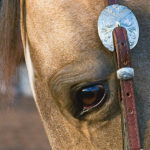Trail riding can be a lot like boating—really fun and relaxing to do, until something goes wrong. Then your F&R gets replaced by anxiety, and the what-ifs that go along with it.

What if the problem’s too big to fix? What if somebody gets hurt? What if you get into so much deep water that a pleasure ride turns into an S-O-S?
This is where troubleshooting skills come in, as your means to save the day when necessary. Whether you’re a veteran or a novice, situations come up when you’re out on the trail, and you can’t always prevent them. But you can be aware that issues are possible, plan accordingly, and not be caught flat-footed. You’re more likely to come through a problem OK when you aren’t out there just expecting to wing it.
Here’s a look at five common scenarios that occur on the trail, with options to consider and the troubleshooting gear or tools that may be needed. If you don’t have a particular item, a riding partner may have it. We’ll cover stone bruising or lost shoe, broken tack, an anxious horse, a dumped rider, and prolonged return back to camp or the barn.
Stone Bruise or Lost Shoe
Situation: Your horse is traveling along nicely, when his gait suddenly feels “off.” After a few more steps, there’s no question: He’s definitely favoring one foot, most likely in front. After dismounting to inspect each foot, you see that he’s picked up a bruising stone, lost a shoe, or both.
What to do: Remove the stone with a hoof pick or other tool. Depending on location against the sole and how hard your horse has stepped on the stone, removal may be all you need to do before remounting and resuming your ride.
If your horse is badly bruised and still gimpy, you need to protect the sole before you can continue. Apply a pre-sized protective boot, if you carry one. Or, pad the sore sole with a sanitary napkin or other soft product, securing it with several layers of duct tape. The protective boot should allow you to continue your ride; the taped-on padding may allow you to do so as well, if you aren’t on rocky ground that quickly shreds the duct-tape covering.
If a shoe is loosened but hanging on, it’s best to pull it so it doesn’t twist and do damage to your horse’s sole. Be sure to remove any protruding nails. Then protect the bare sole with a hoof boot or improvised padding, as explained above.
Should you happen to be caught with no supplies, or your horse is lame despite protection, you may have no choice but to lead him to prevent further damage. Choose the softest footing you can find, along with the shortest route.
Troubleshooting tools: Hoof pick; pliers or shoe-nail nippers; protective hoof boot pre-sized to your horse; sanitary napkin or other padding; duct tape.
Broken Tack
Situation: Your horse steps on a rein and breaks it; your headstall loses a screw and comes apart; or some other key gear item breaks or malfunctions.
What to do: Assess the damage and what you have on hand or can borrow for making an emergency repair. Your horse’s lead rope, if carried, may be all you need for a rein substitute. A length of baling twine will work, too. If a missing screw is the problem—on the crown of your headstall, for instance—you can resecure the leather pieces with a zip tie passed through the screw holes and tightened. (You’ll find that a small packet of assorted zip ties comes in handy for a variety of fixes, and doesn’t take much room in a saddlebag or large pocket.) Or, use another strong material for tying the pieces together.
With the means to punch holes and some extra lacing (cut off a saddle string if necessary), you can splice a rein, cinch billet, stirrup leather, or other strap. If you don’t have a leather punch or awl for piercing the lacing holes, use a pocketknife. Then use zip ties, leather lacing (a saddle string if necessary), or other tie materials to complete the splice.
Duct tape truly does have 1,001 uses, certain saddle fixes included. You can fashion an emergency stirrup with it, for instance, or use multiple wraps to make a temporary cinch billet. The latter fix isn’t recommended for riding, but it’ll at least keep the saddle on your horse so that he’s the one carrying it back to camp, not you.
Troubleshooting tools: Leather punch, awl, or multi-tool pocketknife; spare tack screws; plastic zip ties; leather lacing or strong shoelaces; baling twine; duct tape.
Anxious Horse
Situation: Your horse has done well on trail rides by himself around home, so you take him on a ride with a group—and it’s like he’s a different horse. He won’t walk quietly, won’t settle down, and has himself worked up into a lather. You struggle to keep him at the rear of the group, out of everyone else’s way, but wonder if you’ll both last until the ride ends.
What to do: First, keep in mind that there’s a first time for everything, and that this can be how it goes when a horse has his first experience of going out on trails in a group. To you, “group ride” may mean riding with other people, but to your horse, it means finding himself in a new herd, and perhaps in a new place as well. This can overwhelm him to the point that his survival instincts start to override his training. And the last place instinct tells him to be is at the herd’s tail end, because that’s where a prey animal is most vulnerable to being picked off by a predator.
If possible, call for a group time-out at a safe stopping point (a broad area versus a narrow trail, for instance). This gives you a chance to tell your fellow riders what’s going on, so they can be alert to their own safety, and also gives your horse a chance to settle and catch his breath. Before continuing, get with the group’s leader to discuss the best next plan of action. Yes, you want your horse to pay attention and obey you, but no, you don’t want to fight with him and make the problem worse for all involved.
Often, an unseasoned, anxious horse will do much better when allowed to lead the herd than when he’s forced to follow it. It gives him a clear view of what’s ahead and lets him feel protected from behind. If OK with the ride’s leader, position your horse at the front of the group, with a steady horse behind him. The steady horse will convey confidence to your more uncertain mount, and can come forward, if necessary, to show yours how to handle an obstacle and get through or past it.
A tired horse is usually a much calmer horse, so it’s to your benefit, long term, to continue with the ride rather than return to the barn or trailer. However, if your horse is truly beside himself, and a danger to you, himself, and others, it may be safest to dismount and have an experienced rider pony your horse for part or all of the way. Safety has to come before pride, and there’s no shame in learning that your horse needs more gradual exposure to this type of riding before he can handle it calmly.
Troubleshooting tools: Good horse sense and handling skills; halter and lead, for ponying.
Dumped Rider
Situation: A fellow rider has a problem with her horse, and the next thing you know, is on the ground. She doesn’t get right back up or signal that she’s OK.
What to do: If there’s a trained EMT in your group, clear the way for this rider to get to the downed one ASAP. Otherwise, be ready to render first aid yourself. If you’re with others, let them handle the horses and be on standby to call 911. If you’re the only other person present, grab your phone or two-way radio, if carried, and forget about the horses just now. Your immediate objective is to reach and assess the fallen rider.
Without first-aid training, you may not know what to do first, so here’s an acronym to remember: ABC. For injury or trauma assessment, ABC stands for Airway, Breathing, Circulation—three bodily functions that must be sustained, in that order, without more than brief interruption, for someone’s life to continue.
Let’s say you find the rider conscious but bleeding. Confirm A, that her airway is open; if she can talk, it’s open, but if she’s gagging or not able to breathe in, her airway’s blocked, and you’ll have to help clear it.
After A, confirm B, that the downed rider is able to take regular breaths on her own. If she’s just had her wind knocked out, it should come back within several seconds. Ability to talk is a good sign, and you’ll know if breathing ceases because the rider will become unconscious (requiring immediate CPR). If A and B are OK, with the rider remaining conscious, proceed to C, circulation, and take steps to control the bleeding. Then determine whether the rider is able to rise and continue, or if a call for help is needed.
Troubleshooting tools: Emergency medical training; first-aid kit with means to control bleeding; cell phone or two-way radio, for reaching first responders.
Prolonged Return
Situation: You were expected back from your trail ride within a certain time frame, but something held you up. Now you’re getting a late start back, with daylight burning. You could end up being out after dark, with a worried someone at home.
What to do: If you have a way to call out and advise someone of your situation and location, do it sooner rather than later, before batteries run down. If you’re in a particularly worrisome situation—caught out with a storm on the way, let’s say, and a chance for trails to get bad—start with 911, and again, sooner rather than later. This way your call and time will be on record. Try to reach family or campmates afterward, and without wasting much more daylight.
Assuming you, your horse, and any others are in good shape to ride (injury or sudden illness are different stories) and that weather permits it, you now must assess the variables of distance, fitness, footing, and expertise, before deciding what to do next. You may be in a position to double-time it back at a long trot, or you may need to take time and care for navigating a tricky trail.
In any case, rehydrate before you set out (horses, too, if possible), secure whatever you’re carrying, and if you have them, keep an energy snack and an extra layer of clothing at hand. Should you still find yourself out on the trail as darkness approaches, do any necessary tack adjustments, clothing changes, or gear rearrangements while you still can see what you’re doing. Eat your snack for enough energy to finish the ride.
Troubleshooting tools: Cell phone or two-way radio; water in canteen or bottle; layer of extra clothing; energy snack.






